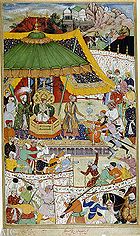
Ain-i-Akbari
Encyclopedia

Vizier
A vizier or in Arabic script ; ; sometimes spelled vazir, vizir, vasir, wazir, vesir, or vezir) is a high-ranking political advisor or minister in a Muslim government....
, Abu'l-Fazl ibn Mubarak
Abu'l-Fazl ibn Mubarak
Shaikh Abu al-Fazl ibn Mubarak also known as Abu'l-Fazl, Abu'l Fadl and Abu'l-Fadl 'Allami was the vizier of the great Mughal emperor Akbar, and author of the Akbarnama, the official history of Akbar's reign in three volumes, and a Persian translation of the Bible...
. It makes the Volume III and the final part of the much larger document, the Akbarnama
Akbarnama
The ' , which literally means Book of Akbar, is the official chronicle of the reign of Akbar, the third Mughal Emperor , commissioned by Akbar himself and written in Persian by his court historian and biographer, Abul Fazl who was one of the nine jewels in Akbar's court...
, the Book of Akbar, also by Abul Fazl
Abu'l-Fazl ibn Mubarak
Shaikh Abu al-Fazl ibn Mubarak also known as Abu'l-Fazl, Abu'l Fadl and Abu'l-Fadl 'Allami was the vizier of the great Mughal emperor Akbar, and author of the Akbarnama, the official history of Akbar's reign in three volumes, and a Persian translation of the Bible...
, and it itself is in three volumes.
Contents
The Ain-i-Akbari is the third volume of the Akbarnama contains information regarding Akbar's reign in the form of, what would be called in modern times, administration reports, statistical compilations, or gazetteers. It contains the áín (i.e., mode of governing) of Akbar, and is, in fact, the administration report and statistical Return of his government. The first volume of the Akbarnama contains the history of TimurTimur
Timur , historically known as Tamerlane in English , was a 14th-century conqueror of West, South and Central Asia, and the founder of the Timurid dynasty in Central Asia, and great-great-grandfather of Babur, the founder of the Mughal Dynasty, which survived as the Mughal Empire in India until...
's family and the reigns of Babar
Babur
Babur was a Muslim conqueror from Central Asia who, following a series of setbacks, finally succeeded in laying the basis for the Mughal dynasty of South Asia. He was a direct descendant of Timur through his father, and a descendant also of Genghis Khan through his mother...
, the Súr kings, and Humayun
Humayun
Nasir ud-din Muhammad Humayun was the second Mughal Emperor who ruled present day Afghanistan, Pakistan, and parts of northern India from 1530–1540 and again from 1555–1556. Like his father, Babur, he lost his kingdom early, but with Persian aid, he eventually regained an even larger one...
. The second volume is devoted to the detailed history of the nearly forty-six years of the Akbar's reign. Since it was written around 1590, it also contains details of Hindu
Hindu
Hindu refers to an identity associated with the philosophical, religious and cultural systems that are indigenous to the Indian subcontinent. As used in the Constitution of India, the word "Hindu" is also attributed to all persons professing any Indian religion...
beliefs and practices as well as a history of India
History of India
The history of India begins with evidence of human activity of Homo sapiens as long as 75,000 years ago, or with earlier hominids including Homo erectus from about 500,000 years ago. The Indus Valley Civilization, which spread and flourished in the northwestern part of the Indian subcontinent from...
.
The Ain-i-Akbari is itself divided into five books. The first book deals with the imperial household, and the second with the servants of the emperor, the military and civil services. The third book deals with the imperial administration, containing the regulations for the judicial and executive departments. The fourth book contains information about Hindu philosophy, science, social customs and literature. The fifth book contains sayings of Akbar, along with an account of the ancestry and biography of the author.
Translations
The original Persian text was translated into English in three volumes. The first volume, translated by H. Blochmann (1873) consisted of Books I and II. The second volume, translated by Colonel H.S. Jarrett (1891), consisted of Book III. The third volume, also translated by Colonel H.S. Jarrett (1896), consisted of Books IV and V. These three volumes were published by the Asiatic SocietyAsiatic Society
The Asiatic Society was founded by Sir William Jones on January 15, 1784 in a meeting presided over by Sir Robert Chambers, the Chief Justice of the Supreme Court at the Fort William in Calcutta, then capital of the British Raj, to enhance and further the cause of Oriental research. At the time of...
of Bengal
Bengal
Bengal is a historical and geographical region in the northeast region of the Indian Subcontinent at the apex of the Bay of Bengal. Today, it is mainly divided between the sovereign land of People's Republic of Bangladesh and the Indian state of West Bengal, although some regions of the previous...
, Calcutta as a part of their Bibliotheca Indica series.
External links
- Ain-e-Akbari, English translation, by H. Blochmannand Colonel H. S. Jarrett, 1873 – 1907. The Asiatic Society of Bengal, Calcutta. at Packard Humanities InstitutePackard Humanities InstituteThe Packard Humanities Institute is a non-profit foundation, established in 1987, and located in Los Altos, California, which funds projects in a wide range of conservation concerns in the fields of archaeology, music, film preservation, and historic conservation, plus Greek epigraphy , with an...
- Ain-e-Akbari, English tr. by Colonel H. S. Jarrett. The Asiatic Society of Bengal, Calcutta. 1948
- Aeene Akbari Part I at Digital Library of India

